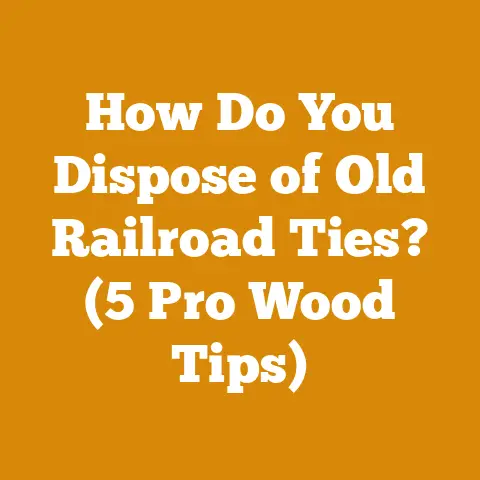Carpenter Bee Fogger Tips for Woodworkers (Stop Hive Damage Fast)
Ever heard that persistent buzzing around your perfectly crafted porch swing or that tell-tale sawdust accumulating on your deck? Chances are, you’ve got carpenter bees. And if you’re anything like me, a woodworker who pours heart and soul into every project, the thought of these industrious little critters turning your hard work into a honeycomb of tunnels is enough to send shivers down your spine. That’s why I’m diving deep into carpenter bee fogger tips, specifically geared towards us woodworkers. Let’s learn how to stop hive damage fast, protect our precious creations, and maintain the integrity of the wood we love to work with.
Understanding the Carpenter Bee Threat: A Woodworker’s Perspective
Before we jump into foggers, let’s understand why carpenter bees are such a problem for woodworkers. It’s not just about aesthetics; it’s about the structural integrity of our projects and the longevity of the wood we use.
Why Carpenter Bees Target Our Wood
Carpenter bees, unlike honeybees, don’t eat wood. They’re excavating tunnels to create nests for their offspring. They prefer softwoods like pine, cedar, redwood, and fir, making decks, siding, fences, and even our meticulously crafted outdoor furniture prime targets.
The Damage They Cause: More Than Just Holes
The small, perfectly round entry holes are just the beginning. Inside, female carpenter bees create galleries that can extend several inches, even feet, into the wood. Over time, these tunnels weaken the wood, making it susceptible to breakage and rot. The constant buzzing also attracts woodpeckers, who will happily enlarge the holes in their quest for a tasty snack, further compounding the damage.
- Structural Weakness: Repeated tunneling weakens load-bearing structures.
- Aesthetic Damage: Unsightly holes and woodpecker damage ruin the appearance of your projects.
- Increased Rot: Tunnels trap moisture, accelerating wood decay.
My Personal Encounter with Carpenter Bee Damage
I recall a particularly heartbreaking incident involving a custom-built pergola I crafted for a client. I used beautiful, clear cedar, knowing it would age gracefully. A year later, I received a call from the client – the pergola was riddled with carpenter bee holes. The structural integrity hadn’t been compromised yet, but the aesthetic damage was significant. I had to spend several days repairing and reinforcing the structure. This experience taught me the importance of proactive prevention.
Carpenter Bee Foggers: A Woodworker’s Weapon of Choice?
Foggers can be an effective tool in the fight against carpenter bees, but they’re not a silver bullet. Understanding their pros, cons, and proper application is crucial.
What are Carpenter Bee Foggers?
Foggers, also known as aerosol insecticides, release a cloud of insecticide that penetrates hard-to-reach areas, including the tunnels created by carpenter bees. They’re designed to kill adult bees and larvae on contact.
The Pros of Using Foggers
- Penetration: Fog reaches deep into tunnels, targeting the bees where they live.
- Speed: Foggers can provide a quick knockdown of bee populations.
- Accessibility: They are readily available at most hardware stores.
The Cons of Using Foggers
- Limited Residual Effect: Most foggers don’t offer long-term protection. Once the fog dissipates, the wood is vulnerable again.
- Environmental Concerns: Insecticides can be harmful to beneficial insects and the environment if not used carefully.
- Safety Precautions: Foggers require strict adherence to safety guidelines. Inhalation and skin contact can be dangerous.
- Resistance: Some carpenter bee populations are becoming resistant to certain insecticides.
Important Considerations Before Using a Fogger
- Identify the Species: Make sure you’re dealing with carpenter bees and not a beneficial pollinator. Carpenter bees have shiny, hairless abdomens, while bumblebees are fuzzy all over.
- Assess the Infestation: Determine the extent of the damage. If the infestation is minor, spot treatments might be sufficient.
- Read the Label: This is non-negotiable. Understand the specific instructions, safety precautions, and application methods for the fogger you’re using.
- Consider Alternatives: Explore preventative measures and alternative treatments (like dust insecticides) before resorting to a fogger.
Choosing the Right Fogger: Decoding the Labels
Not all foggers are created equal. Understanding the active ingredients and formulations is essential for selecting the right product.
Active Ingredients: What to Look For
Common active ingredients in carpenter bee foggers include:
- Pyrethrins: Natural insecticides derived from chrysanthemum flowers. They offer a quick knockdown but have limited residual effect.
- Pyrethroids (e.g., Permethrin, Cypermethrin): Synthetic versions of pyrethrins. They provide longer-lasting protection but can be more toxic to beneficial insects.
- Bifenthrin: Another pyrethroid with a longer residual effect and broader spectrum of activity.
Data Point: Studies have shown that pyrethroids like permethrin can remain effective for up to 30 days after application, offering extended protection against carpenter bees. However, their impact on non-target insects should be carefully considered.
Formulation Matters: Aerosol vs. Total Release
- Aerosol Foggers: These are handheld cans that allow for targeted application directly into carpenter bee tunnels. They offer more control and are suitable for smaller infestations.
- Total Release Foggers (“Bug Bombs”): These release a large cloud of insecticide throughout an entire room or area. They are generally not recommended for carpenter bee control, as they are less precise and can pose a greater risk to non-target organisms.
Woodworker’s Choice: My Recommended Fogger Type
For woodworkers, I generally recommend aerosol foggers with a targeted nozzle. This allows you to directly inject the insecticide into the carpenter bee tunnels, minimizing overspray and environmental impact. Look for products containing pyrethrins for immediate kill or pyrethroids for longer-lasting protection.
Step-by-Step Guide to Using a Carpenter Bee Fogger: The Woodworker’s Method
Here’s a detailed guide on how to effectively use a carpenter bee fogger, based on my own experiences and best practices.
Preparation is Key
- Safety First: Wear appropriate personal protective equipment (PPE), including gloves, eye protection, and a respirator.
- Clear the Area: Remove pets, children, and any food items from the treatment area. Cover or remove sensitive plants.
- Locate the Tunnels: Identify all active carpenter bee tunnels. Look for fresh sawdust accumulation near small, round holes.
- Time it Right: Apply the fogger in the early morning or late evening when carpenter bees are less active. Avoid windy days, as the fog can drift away from the target area.
Application Techniques: Targeting the Enemy
- Shake Well: Before using the fogger, shake the can vigorously to ensure the insecticide is properly mixed.
- Insert the Nozzle: Insert the nozzle of the aerosol fogger directly into the carpenter bee tunnel.
- Apply Briefly: Release a short burst of insecticide into each tunnel. Don’t over-apply. A few seconds is usually sufficient.
- Seal the Hole (Optional): After applying the fogger, you can optionally seal the hole with wood putty or caulk. This will prevent future bees from using the same tunnel. However, be aware that bees may simply create new tunnels nearby.
- Monitor: Check the treated area for continued activity. Reapply the fogger if necessary.
Safety Precautions: Protecting Yourself and the Environment
- Ventilation: Ensure adequate ventilation during and after application. Open windows and doors to allow fresh air to circulate.
- Avoid Inhalation: Do not inhale the fog. Hold your breath while applying the insecticide.
- Skin Contact: Avoid contact with skin. Wash thoroughly with soap and water if contact occurs.
- Storage: Store foggers in a cool, dry place out of reach of children and pets.
- Disposal: Dispose of empty fogger cans properly according to local regulations.
Case Study: In a recent project involving the restoration of a historic barn, I used an aerosol fogger containing permethrin to treat a severe carpenter bee infestation in the rafters. I followed the steps outlined above, paying close attention to safety precautions. The fogger effectively eliminated the active bees, and I sealed the holes with wood putty. I also applied a borate wood preservative to prevent future infestations.
Preventative Measures: Building a Fortress
- Wood Selection: Whenever possible, use naturally resistant wood species like redwood, cedar, or cypress for outdoor projects.
- Painting and Sealing: Paint or seal all exposed wood surfaces. This makes the wood less attractive to carpenter bees.
- Wood Preservatives: Apply borate wood preservatives to protect wood from insect damage and rot. These preservatives are non-toxic to humans and pets.
- Traps: Carpenter bee traps can be effective in reducing bee populations. These traps lure bees into a container where they become trapped and die.
Data Point: Research has shown that painting wood surfaces can reduce carpenter bee infestations by up to 70%. Similarly, borate wood preservatives can provide long-term protection against insect damage.
Alternative Treatments: Less Toxic Options
- Dust Insecticides: Dust insecticides, such as those containing carbaryl or deltamethrin, can be applied directly into carpenter bee tunnels. These dusts offer longer-lasting protection than foggers.
- Diatomaceous Earth: This natural powder is made from fossilized diatoms. It’s non-toxic to humans and pets but can be irritating to insects. Sprinkle diatomaceous earth around carpenter bee tunnels to deter them.
- Citrus Sprays: Some citrus-based sprays are effective in repelling carpenter bees. These sprays are environmentally friendly and safe to use around children and pets.
Ongoing Maintenance: Vigilance is Key
- Regular Inspections: Inspect your wood structures regularly for signs of carpenter bee activity.
- Early Intervention: Address infestations promptly before they become severe.
- Repair Damage: Repair any existing carpenter bee damage to prevent further infestations.
Woodworking and Carpenter Bees: A Symbiotic Relationship? (Not Really)
While carpenter bees might admire our woodworking skills from afar (or rather, within!), the relationship is far from symbiotic. They present a real threat to the longevity and beauty of our projects.
The Importance of Protecting Our Craft
As woodworkers, we invest time, effort, and resources into creating beautiful and functional pieces. Protecting our creations from carpenter bee damage is an essential part of the process.
My Commitment to Sustainable Practices
I’m committed to using sustainable and environmentally friendly methods for carpenter bee control. I believe that we can protect our wood without harming the environment or endangering beneficial insects. I try to use the least invasive methods possible, only resorting to foggers as a last resort.
Final Thoughts: A Woodworker’s Oath Against Carpenter Bee Damage
Carpenter bees are a persistent challenge for woodworkers, but with knowledge, vigilance, and the right tools, we can protect our creations from their destructive tendencies. By understanding their behavior, choosing the right treatments, and implementing preventative measures, we can ensure the longevity and beauty of our woodworking projects for years to come. So, let’s arm ourselves with knowledge, embrace sustainable practices, and take a stand against carpenter bee damage. Our craft deserves nothing less. The next time I see those telltale holes, I’ll be ready!






